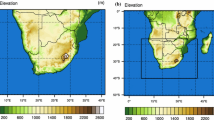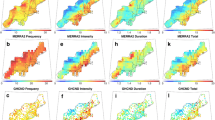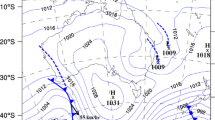Abstract
We present an analysis of the seasonal, subseasonal, and diurnal variability of rainfall from COAPS Land–Atmosphere Regional Reanalysis for the Southeast at 10-km resolution (CLARReS10). Most of our assessment focuses on the representation of summertime subseasonal and diurnal variability. Summer precipitation in the Southeast United States is a particularly challenging modeling problem because of the variety of regional-scale phenomena, such as sea breeze, thunderstorms and squall lines, which are not adequately resolved in coarse atmospheric reanalyses but contribute significantly to the hydrological budget over the region. We find that the dynamically downscaled reanalyses are in good agreement with station and gridded observations in terms of both the relative seasonal distribution and the diurnal structure of precipitation, although total precipitation amounts tend to be systematically overestimated. The diurnal cycle of summer precipitation in the downscaled reanalyses is in very good agreement with station observations and a clear improvement both over their “parent” reanalyses and over newer-generation reanalyses. The seasonal cycle of precipitation is particularly well simulated in the Florida; this we attribute to the ability of the regional model to provide a more accurate representation of the spatial and temporal structure of finer-scale phenomena such as fronts and sea breezes. Over the northern portion of the domain summer precipitation in the downscaled reanalyses remains, as in the “parent” reanalyses, overestimated. Given the degree of success that dynamical downscaling of reanalyses demonstrates in the simulation of the characteristics of regional precipitation, its favorable comparison to conventional newer-generation reanalyses and its cost-effectiveness, we conclude that for the Southeast United states such downscaling is a viable proxy for high-resolution conventional reanalysis.














Similar content being viewed by others
References
Abbs DJ, Physick WL (1992) Sea-breeze observations and modeling: a review. Aust Met Mag 41:7–19
Betts, AK, Zhao M, Dirmeyer PA, Beljaars ACM (2006) Comparison of ERA40 and NCEP/DOE near-surface data sets with other ISLSCP-II data sets. J Geoph Res 111. doi:10.1029/2006JD007174
Blanchard DO, López RE (1985) Spatial patterns of convection in South Florida. Mon Weather Rev 113:1282–1299
Bosilovich MG, Schubert SD, Rienecker M, Todling R, Suarez M, Bachmeister J, Gelaro R, Kim G-K, Stajner I and Chen J (2006) NASA's modern era retrospective analysis for research and applications. US CLIVAR Variations 4:5–8
Byers HR, Rodebush HR (1948) Causes of thunderstorms of the Florida peninsula. J Meteorol 5:275–280
Castro CLS, Pielke RA, Leoncini G (2005) Dynamical down-scaling: assessment of value retained and added using the regional atmospheric modeling system (RAMS). J Geophys Res 110. doi:10.1029/2004JD004721
Chou MD, Lee KT (1996) Parameterizations for the absorption of solar radiation by water vapor and ozone. J Atmos Sci 53:1203–1208
Chou MD, Suarez MJ (1994) An efficient thermal infrared radiation parameterization for use in general circulation models. Technical report series on global modeling and data assimilation, NASA/TM-1994-104606, 3, 85 p
Clark JS, Carpenter SR, Barber M, Collins S, Dobson A, Foley JA, Lodge DM, Pascual M, Pielke R Jr, Pizer W, Pringle C, Reid WV, Rose KA, Sala O, Schlesinger WH, Wall DH, Wear D (2001) Ecological forecasts: an emerging imperative. Science 293(5530):657–660. doi:10.1126/science.293.5530.657
Daly C, Neilson RP, Phillips DL (1994) A statistical-topographic model for mapping climatological precipitation over mountainous terrain. J Appl Meteorol 33:140–158
Dickinson MJ, Bosart LF, Bracken WE, Hakim GJ, Schultz DM, Bedrick MA, Tyler KR (1997) The March 1993 Superstorm cyclogenesis: incipient phase synoptic- and convective-scale flow interaction and model performance. Mon Weather Rev 125:3041–3072
Ek MB, Mitchell KE, Lin Y, Rogers E, Grunmann P, Koren V, Gayno G, Tarpley JD (2003) Implementation of Noah land surface model advances in the national centers for environmental prediction operational mesoscale Eta model. J Geophys Res 108(D22):8851. doi:10.1029/2002JD003296
Higgins RW, Janowiak JE, Yao Y-P (1996) A gridded hourly precipitation data base for the United States (1963–1993). NCEP/Climate Prediction Center Atlas 1, National Centers for Environmental Prediction, 46 p
Hong S-Y, Pan H-L (1996) Nonlocal boundary layer vertical diffusion in a medium-range forecast model. Mon Weather Rev 124:2322–2339
Huffman GJ, Adler RF, Bolvin DT, Gu G, Nelkin EJ, Bowman KP, Hong Y, Stocker EF, Wolff DB (2007) The TRMM multi-satellite precipitation analysis: quasi-global, multi-year, combined-sensor precipitation estimates at fine scale. J Hydrometeor 8:38–55
Juang H-M, Kanamitsu M (1994) The NMC nested regional spectral model. Mon Weather Rev 122:3–26
Kalnay E et al (1996) The NCEP/NCAR 40-year reanalysis project. Bull Am Meteorol Soc 77:437–471
Kanamaru H, Kanamitsu M (2007a) Scale-selective bias correction in a downscaling of global analysis using a regional model. Mon Weather Rev 135:334–350
Kanamaru H, Kanamitsu M (2007b) Fifty-seven-year reanalysis downscaling at 10 km (CaRD10). Part II: comparison with North American regional reanalysis. J Climate 20:5572–5592
Kanamitsu M, Kanamaru H (2007) Fifty-seven-year reanalysis downscaling at 10 km (CaRD10). Part I: system detail and validation with observations. J Climate 20:5553–5571
Kanamitsu M, Ebisuzaki W, Woollen J, Yang S-K, Hnilo J, Fiorino M, Potter GL (2002) NCEP-DOE AMIP-II reanalysis (R-2). Bull Am Meteorol Soc 83:1631–1643
Kocin KJ, Schumacher PN, RF MoralesJR, Uccellini LW (1995) Overview of the 12–14 March 1993 Superstorm. Bull Amer Meteor Soc 76:165–182
Lim Y-K, Stefanova LB, Chan SC, Schubert SD, O’Brien JJ (2010) High-resolution subtropical summer precipitation derived from dynamical downscaling of the NCEP/DOE reanalysis: how much small-scale information is added by a regional model? Clim Dyn 35. doi:10.1007/s00382-010-0891-2
Lin Y, Mitchell KE (2005) The NCEP stage II/IV hourly precipitation analyses: development and applications. Preprints 19th Conference on Hydrology, American Meteorological Society, San Diego, CA
Messinger F, Dimego G, Kalnay E, Mitchell K, Shafran P, Ebisuzaki W, Jovic D, Woollen J, Rogers E, Berbery E, Ek M, Fan Y, Grumbine R, Higgins W, Li H, Lin Y, Manikin G, Parrish D, Shi W (2006) North American regional reanalysis. Bull Am Meteorol Soc 87:343–360
Michaels JP, Pielke R, McQueen JT, Sappington DE (1987) Composite climatology of Florida summer thunderstorms. Mon Weather Rev 115:2781–2791
Misra V, Moeller L, Stefanova L, Chan S, O’Brien JJ, Smith TJ III, Plant N (2010) The influence of Atlantic Warm Pool on Florida sea breeze. J Geoph Res (in review)
Pan H-L, Mahrt L (1987) Interaction between soil hydrology and boundary layer developments. Boundary-Layer Meteorol 38:185–202
Pan H-L, Wu W-S (1994) Implementing a mass-flux convective parameterization package for the NMC medium range forecast model. Preprints, 10th conference on numerical weather prediction, Portland, OR, American Meteorological Society, pp 96–98
Rahbek C, Graves GR (2001) Multiscale assessment of patterns of avian richness. PNAS 98 (8):4534–4539. doi:10.1073/pnas.071034898
Saha S et al (2010) The NCEP climate forecast system reanalysis. Bull Am Meteorol Soc. doi:10.1175/2010BAMS3001.1
Schwarts BE, Bosart L (1979) The diurnal variability of Florida rainfall. Mon Weather Rev 107:1535–1545
Shukla J, Hagedorn R, Hoskins B, Kinter J, Marotzke J, Miller M, Palmer T, Slingo J (2009) Revolution in climate prediction is both possible and necessary. A declaration at the world modelling summit for climate prediction. Bull Am Meteorol Soc. doi:10.1175/2008BAMS 2759.1
Silva VBS, Kousky VE, Higgins RW (2011) Daily precipitation statistics for South America: an intercomparison between NCEP reanalyses and observations. J Hydrometeor 12:101–117
Slingo JM (1987) The development and verification of a cloud prediction scheme for the ECMWF model. Q J Roy Meteorol Soc 113:899–927
Smith TM, Reynolds RW, Peterson TC, Lawrimore J (2008) Improvements to NOAA’s historical merged land-ocean surface temperature analysis (1880–2006). J Climate 21:2283–2296
Stefanova L, Misra V, O’Brien JJ, Chassignet EP, Hameed S (2011) Hindcast skill and predictability for precipitation and two-meter air temperature anomalies in global circulation models over the Southeast United States. Clim Dyn 36. doi:10.1007/s00382-010-0988-7
Uppala SM et al (2006) The ERA40 re-analysis. Q J Roy Meteorol Soc. doi:10.1256/qj.04.176
von Storch H, Langenberg H, Feser F (2000) A spectral nudging technique for dynamical downscaling purposes. Mon Weather Rev 128:3664–3673
Warner TT, Peterson RA, Treadon RE (1997) Tutorial on lateral boundary conditions as a basic and potentially serious limitation to regional numerical weather prediction. Bull Am Meteorol Soc 78:2599–2618
Winsberg MD (2003) Florida Weather. University Press of Florida, Florida
Acknowledgments
The authors would like to express their gratitude to Dr. Kei Yoshimura for his assistance with the RSM model, Ms. Lauren Moeller for her help with data aggregation and storage, Ms. Kathy Fearon for her editorial comments, Dr. David Sumner and three anonymous reviewers whose helpful comments and thoughtful critique of the manuscript have significantly improved it, and The Florida State University shared High-Performance Computing facility and staff for providing computational resources for this study. The CPC Daily US Unified Precipitation and NCEP-DOE Reanalysis II data were provided by the NOAA/OAR/ESRL PSD, Boulder, Colorado, USA, from their web site at http://www.esrl.noaa.gov/psd/; PRISM monthly precipitation was provided by the PRISM Climate Group at Oregon State University from their website at http://www.prism.oregonstate.edu; ECMWF-ERA40 Reanalysis data were provided by the ECMWF from their data server at http://data.ecmwf.int. MERRA data were made available by the Global Modeling and Assimilation Office (GMAO) and the GES DISC. Funding for this project was provided by grants from NOAA, USDA CREES and USGS.
Author information
Authors and Affiliations
Corresponding author
Rights and permissions
About this article
Cite this article
Stefanova, L., Misra, V., Chan, S. et al. A proxy for high-resolution regional reanalysis for the Southeast United States: assessment of precipitation variability in dynamically downscaled reanalyses. Clim Dyn 38, 2449–2466 (2012). https://doi.org/10.1007/s00382-011-1230-y
Received:
Accepted:
Published:
Issue Date:
DOI: https://doi.org/10.1007/s00382-011-1230-y




